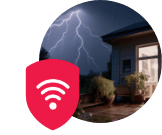Top 3 Internet Providers for Digital Nomads and Remote Workers

Table of Contents
You’re currently camping in Colorado, uploading your latest project without missing a beat. This is a realistic experience for today’s digital nomads and remote workers; reliable internet isn’t just nice to have—it’s the lifeline that makes location independence possible. We’re going to be breaking down the top 3 internet providers for digital nomads, as well as some alternative backup solutions.
Working remotely used to mean being chained to coffee shops with sketchy WiFi or desperately hunting for internet cafes. Not anymore! The digital nomad lifestyle has gained immense popularity, with millions of professionals discovering that they can work from virtually anywhere on Earth. But here’s the catch: your freedom is only as strong as your internet connection.
One dropped Zoom call with an important client, or a painfully slow upload speed that turns a simple presentation into an all-day ordeal, and suddenly that dream lifestyle starts feeling more like a nightmare.
Understanding Your Internet Needs as a Digital Nomad
Your baseline internet requirements for working remotely start with a 25 Mbps download speed and 10 Mbps upload for basic functionality. But your specific needs depend heavily on what type of work you do.
If you frequently host video conferences, upload large files, or stream content, you’ll require significantly more bandwidth. Video calls and online meetings consume between 1 and 1.5 GB per hour in standard quality, while working in the cloud with services like Google Drive or Dropbox can consume between 5 and 10 GB per month.
For most remote workers, data usage typically ranges from light users consuming around 50 GB per month to heavy users who might consume over 200 GB per month. Understanding your usage patterns helps you choose the right provider and plan without overpaying for data you don’t need or getting stuck with insufficient bandwidth.

Internet on-the-go solutions
The Top 3 Internet Providers for Digital Nomads
Starlink
Starlink has completely transformed what’s possible for digital nomads who want to venture off the beaten path. The Starlink Mini is a portable satellite that can be used in many parts of the world, providing super-fast Wi-Fi in even the most remote areas. This isn’t your grandfather’s slow, expensive satellite internet—Starlink delivers speeds between 50-250 Mbps download, making it competitive with traditional broadband.
What makes Starlink special is its ability to work literally anywhere with a clear view of the sky. Remote ecolodges, jungle retreats, mountaintop cabins, or a catamaran in the ocean can now offer stable internet, allowing digital nomads to stay longer and work more efficiently. You can finally have that sunrise video call from a mountaintop or upload your work while camping in the wilderness.
Starlink Plans and Pricing
Starlink keeps plans straightforward with three main residential tiers. The Residential plan (best suited for households) offers unlimited data at speeds of up to 300 Mbps for $80 (the Lite plan) to $120 per month. Residential Lite is recommended for low usage, smaller households due to the fact that their plan is prioritized behind Residential users, so they will see slower speeds during peak hours. The standard equipment fee runs $349 for the Standard kit.
The second “personal” plan offered is Roam, which offers countrywide coverage, in-motion use, international travel, coastal coverage, and the ability to pause service. This is recommended for RVs, nomads, campers, and anyone working on the go. For 50GB of data, you can expect around $50/month, and for unlimited data, it will cost about $165/month.
Businesses have access to eight different plans, categorized by Local Priority and Global Priority. Local Priority is for fixed and mobile businesses on land, offering single country land use and regional travel, network priority, reliable fixed and in-motion use, and a public IP and dashboard. These plans range from 50 GB for $65 per month to 2 TB for $540 per month. Global priority plans are ideal for businesses seeking global connectivity, as well as maritime businesses. Key features include ocean and global land use, network priority, reliable fixed and in-motion use, and public IP and dashboard. These plans range from 50 GB for $250 per month to 2 TB for $2,150 per month. All business plans can be customized with additional blocks of data if extra data is required.
*Equipment fees apply. Pricing is subject to change by location.
Verizon
For digital nomads who primarily work within the United States, Verizon is the gold standard for mobile internet connectivity. Verizon wields the best combined 4G and 5G coverage in the United States, so you can rest assured that you’ll actually have a signal to power your hotspot data usage no matter where you go.
Verizon’s Premium Plans for Remote Workers
Verizon recently upgraded its top-tier plan with digital nomads in mind. Verizon’s Unlimited Ultimate Plan now comes with some major additional features, remaining at the same $90/mo for a single line of service [1]. The high-speed hotspot data allowance increases from 60 GB to 200 GB, with unlimited hotspot throttled to 6 Mbps after.
This makes Verizon’s Unlimited Ultimate the top plan for smartphone hotspot data, eclipsing the consumer and even business offerings from both AT&T and T-Mobile. For power users, Verizon’s myPlan system of optional perks allows customers to add an additional 100 GB of full-speed hotspot data for $10, for a total of 300 GB [1].
Mobile Hotspot Devices
Beyond smartphone plans, Verizon offers dedicated hotspot devices that are perfect for digital nomads. The Verizon Jetpack MiFi® 8800L by Inseego and the Inseego MiFi M2100 5G UW are Verizon’s global-ready high-speed mobile hotspot devices. They’re compatible with global data services in over 200 countries [2].
These devices offer significant advantages:
- Battery life: A mobile hotspot device has its own battery, so it won’t drain the battery on your smartphone or tablet.
- Flexibility: If you’re sharing your network connection with others, you can leave the mobile hotspot device behind for them to continue using, rather than your smartphone or tablet.
T-Mobile
T-Mobile rounds out our top three with competitive pricing and excellent international features, making it particularly attractive for nomads who travel globally. T-Mobile’s Experience More is $90/month, offering features such as a big 60GB high-speed mobile hotspot data allowance, not to mention free Netflix With Ads, free Apple TV+, and a host of travel perks like free in-flight texting and WiFi [3].
For nomads who need even more data, T-Mobile’s premium smartphone plan comes with even more data than Verizon’s plan, and you get mobile data in more than 215 countries. This plan is an expensive one, but it’s the best way for travelers to stay connected constantly.
5G Performance
T-Mobile has invested heavily in 5G infrastructure, making it a strong choice for nomads who need cutting-edge speeds in urban areas. 5G is transforming urban remote work with ultra-fast speeds and low latency, making it ideal for digital nomads in cities.

Back-up internet options
Alternative Internet Solutions for Digital Nomads
eSIMs
eSIM technology has upgraded international connectivity for digital nomads. eSIMs offer a convenient solution for travelers, eliminating the need to swap physical SIM cards.
Public WiFi and Coworking Spaces
While not a primary solution, public WiFi can supplement your main internet connection. However, use it wisely. According to Cybersecurity Ventures, 36% of all security breaches begin with phishing attacks, many of which are launched via unsecured or poorly protected networks, such as those found in cafés and restaurants [4].
Coworking spaces offer a more secure alternative. Most coworking networks invest in secure, enterprise-level internet infrastructure, so you’re not at the mercy of unreliable guest networks. Many nomad-friendly destinations now offer excellent coworking facilities with reliable, high-speed internet, specifically designed for remote workers.
Mobile Hotspot Devices
Dedicated mobile hotspot devices offer several advantages over smartphone tethering:
- Longer battery life dedicated to internet connectivity
- Ability to connect more devices simultaneously
- Often, better signal strength and range
- Option to leave the device for others to use
Pro Tips for Maximum Connectivity
Create Redundancy
The most successful digital nomads never rely on a single internet source. Consider this multi-layered approach:
- Primary: Your main provider (Starlink, Verizon, or T-Mobile)
- Secondary: An eSIM with data for backup connectivity
- Tertiary: Access to local coworking spaces or cafes with reliable WiFi
Monitor Your Data Usage
Video calls and online meetings consume between 1 and 1.5 GB per hour in standard quality. If you participate in daily meetings, that adds up to about 20 hours per month. This translates to 20-30 GB of data. Understanding your patterns helps you choose the right plan and avoid overages.
Consider Local Solutions for Extended Stays
While international providers offer convenience, local SIM cards and internet plans often provide better value for stays longer than a month. Research local options when planning extended stays in specific countries.
Test Before You Travel
Most providers offer trial periods or small data packages. Test your chosen solution in your home area before relying on it for important work while traveling.
Ready to Find Your High-Speed Internet Provider?
Choosing the right internet provider is the first step in your digital nomad adventure. The key is understanding your specific needs, testing different solutions, and building redundancy into your connectivity strategy.
Whether you’re drawn to Starlink’s revolutionary satellite coverage, Verizon’s rock-solid U.S. reliability, or T-Mobile’s international-friendly features, the right solution is out there waiting for you. The world has truly become your office—you just need the right internet connection to unlock it.
Enter your zip code here to find top providers and deals in your area.
Sources
[2] Verizon.com. “Mobile Devices Mobile Workforce Ultimate Guide Digital Nomads"
[3] Yournavi.com. “Unlimited Hotspot Plans"
[4] Cybersecurityventures.com. “Web Browsers are Doorways to Cyberattacks"












 Call
Call 

 Access Your Account
Access Your Account